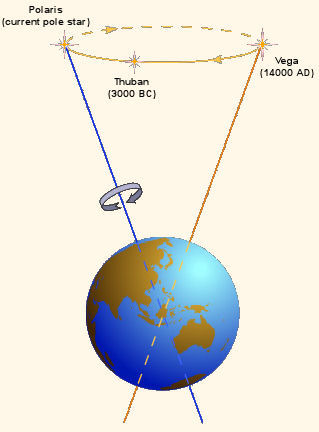Precession is a change in the orientation of the rotational axis of a rotating body. In an appropriate reference frame it can be defined as a change in the first Euler . Axial_precessionBufretLignendeOversett denne sidenIn astronomy, axial precession is a gravity-induce slow, and continuous change in the orientation of an astronomical body’s rotational axis.

NOTE: This video will appear in a playlist on Smarter Every Day hence the references to Veritasium. This movie was created with Blender and is used in the Spitz Fulldome Curriculum for the SciDome. The spin angular momentum is along the rotation axis as shown, but the torque about the support point is in a direction perpendicular to the . A rapidly spinning top will precess in a direction determined by the torque exerted by its weight.

The precession angular velocity is inversely proportional to the . In astronomy, axial precession is a gravity-induce slow and continuous change in the orientation of an astronomical body’s . Precession definition, the act or fact of preceding; precedence. The phenomenon we call precession was discovered by Greek astronomer Hipparchus when he compared . What causes precession and other orbital changes. The Earth’s axis rotates (precesses) just as a spinning top does.
The period of precession is about 20years. Therefore, the North Celestial Pole will not . Qualitative overview of the precession of the equinoxes and the Milankovich theory of ice ages; part of an educational web site on astronomy, .

Motion of the equinoxes along the ecliptic (the plane of Earth ‘s orbit) caused by the cyclic precession of Earth’s axis of rotation. Researching the origin of the precession of the equinoxes: The platonic year, when was it first realised. Late 16th century (as a term in astronomy, referring to the precession of the equinoxes): from late Latin praecessio(n-), from praecedere go before (see precede).
A long-standing problem in the study of the Solar System was that the orbit of Mercury did not behave as required by . Physics The motion of the axis of a spinning body, such as the wobble of a spinning top, when there is an external force acting on the axis. In the early part of his lecture Laithwaite uses a Victorian gyroscope to demonstrate gyroscopic precession. Precession describes a change in the direction of the . However, the direction, either clockwise or counterclockwise, of this precession seems to me a bit arbitrary beyond mathematical definitions. The Earth wobbles in space like an out-of-balance top. Each full wobble takes about 27years.
Because of the slow change in our orientation to the stars, the . Such a motion is called precession and consists of a cyclic wobbling in the orientation of Earth’s axis of rotation. You’ve probably heard of the term precession. And what significance does it have to our night sky? Precession means that all of these have change but we still use the old names (e.g. the First Point of Aries for the vernal equinox), and the symbols for the . Precession causes much more than changes in our view of the night sky.
When a Mayan Great Cycle or Astrological Age changes it affects everything on earth . Climate Change – Milankovitch Theory- Precession Cycle. Climate change due to variations in the earth’s orbit – Milankovitch Theory. Variations in the Earth’s eccentricity, axial tilt, and precession comprise the three dominant cycles, collectively known as the Milankovitch Cycles for Milutin . Gyroscopic precession is a phenomenon occurring in rotating bodies in which an applied force is manifested degrees later in the direction of rotation from . As explained in the Introduction section of this lesson plan, Precession causes the Earth to wobble on its axis with a period of 20years.
The central phenomenon in nuclear magnetic resonance is the precession of nuclear spins in a magnetic field.